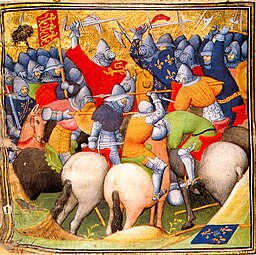Valois Dynasty and Hundred Year's War
History of France between 1329 - 1453
Valois Dynasty, the royal house of France from 1328 to 1589, ruled the nation from the end of the feudal period into the early modern age. The Valois kings continued the work of unifying France and centralizing royal power begun under their predecessors, the Capetian dynasty. The House of Valois was a branch of the Capetian family, for it was descended from Charles of Valois, whose Capetian father, King Philip III, awarded him the county of Valois in 1285. Charles’s son and successor, Philip, count of Valois, became king of France as Philip VI in 1328, and thus began the Valois dynasty.
The early kings of the Valois dynasty were occupied primarily with fighting the Hundred Years’ War (1337–1453), which broke out under Philip VI (reigned 1328–50). During this period the monarchy was threatened both by the English, who at times controlled much of France, and by the revived strength of feudal lords, such as the Armagnac and Burgundian factions, which challenged the supremacy of the kings. The Hundred Years’ War was a series of armed conflicts between England and France and originated from disputed claims to the French throne between the English royal House of Plantagenet and the French royal House of Valois. Over time, the war grew into a broader power struggle involving factions from across Western Europe, fueled by emerging nationalism on both sides. The war was one of the most notable conflicts of the Middle Ages. For 116 years, interrupted by several truces, five generations of kings from two rival dynasties fought for the throne of the largest kingdom in Western Europe. The war’s effect on European history was lasting. Both sides produced innovations in military technology, and tactics, such as professional standing armies and artillery, that permanently changed warfare in Europe; chivalry, which had reached its height during the conflict, subsequently declined. Stronger national identities took root in both countries, which became more centralised and gradually rose as global powers.
The term "Hundred Years’ War" was adopted by later historians as a historiographical periodisation to encompass related conflicts, constructing the longest military conflict in European history. The war is commonly divided into three phases separated by truces: the Edwardian War (1337–1360), the Caroline War (1369–1389), and the Lancastrian War (1415–1453). Each side drew many allies into the conflict, with English forces initially prevailing; the House of Valois ultimately retained control over France, with the previously-intertwined French and English monarchies thereafter remaining separate. The crown’s exclusive right to levy taxes and to wage war was also established and many of the basic administrative institutions that had begun to develop under the Capetians continued to evolve under the Valois. For example, the Parlements (courts) were extended throughout France to dispense royal justice.
Reference: Britannica, Wikipedia
Previous historical period: Late Capetians (1180-1328)Popular sites founded between 1329 and 1453 in France
Kammerzell House
Strasbourg, France
1427
Cordeliers Cloister
Saint-Émilion, France
14th century
Village of Èze
Èze, France
14th century
Saint-Pierre Basilica
Avignon, France
1358
Saint-Nicholas-des-Champs Church
Paris, France
1420
Château de Saint-Malo
Saint-Malo, France
1424
Château de Gordes
Gordes, France
14th century
Sainte-Chapelle de Vincennes
Vincennes, France
1379
Château de Vincennes
Vincennes, France
1340-1410
Saint-Paul-de-Vence Village
Saint-Paul-de-Vence, France
Middle Ages
Porte Saint-Pierre
Nantes, France
15th century
Nantes Cathedral
Nantes, France
1434
Donjon Lacataye
Mont-de-Marsan, France
14th century
Basilica of St. Michael
Bordeaux, France
14th century
Saint-Tropez Towers
Saint-Tropez, France
1565
Château de Pierrefonds
Pierrefonds, France
1393
Église Saint-Pierre
Bordeaux, France
14th century
Yvoire Medieval Town
Yvoire, France
14th century
Church of Saint-Maclou
Rouen, France
c. 1432
Saint-Nizier Church
Lyon, France
14th century
Saint-Maurice Church
Lille, France
14th century
Château d'Usse
Rigny-Ussé, France
1440s
Montpellier Cathedral
Montpellier, France
1364
Notre-Dame en Saint-Melaine Church
Rennes, France
14th century
